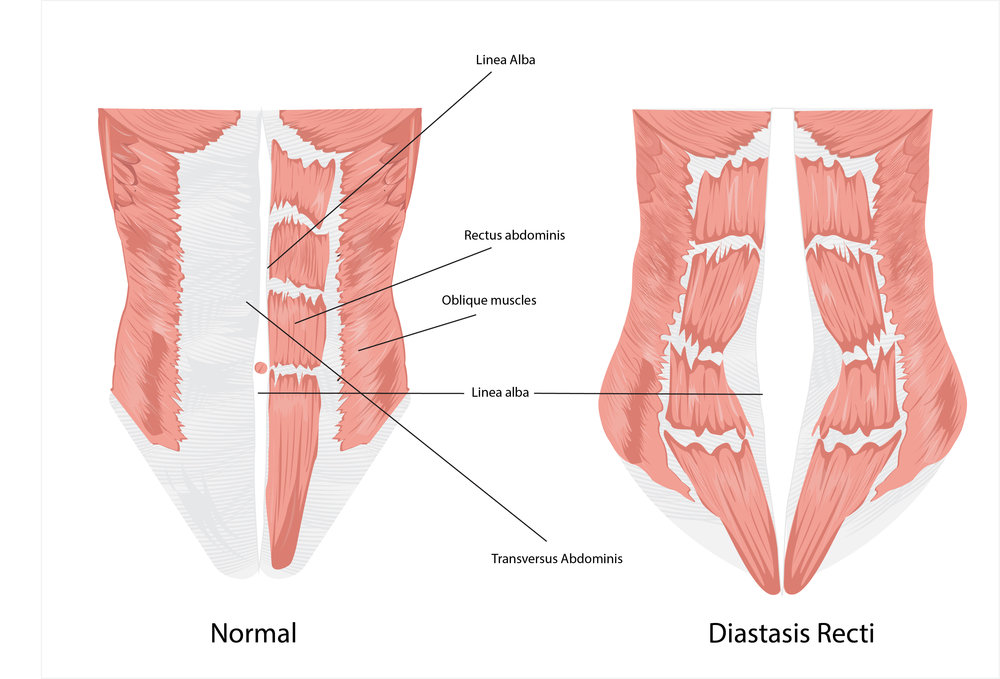Diastasis recti or abdominal separation occurs commonly amongst two-thirds of pregnant women and can also occur in men.
During pregnancy, your muscles and connective tissues expand due to an influx of estrogen and relaxin hormones. As the baby grows and your abdominal muscles stretch to accommodate the growth, some separation in the rectus abdominis (“six-pack” muscle) is expected and normal. This separation naturally recovers after birth between the first day and 8 weeks of birth. [1] A 1.5 to 2cm separation at the level of the umbilicus is considered normal after pregnancy. [2] A separation >2.7cm at the level of the umbilicus is considered a pathological diastasis of the rectus abdominis. [3]
May be caused by:
Heavy babies, twins, triplets
Pressure on frontal abdominal muscle- rectus abdominis during pregnancy
Performing repetitive and incorrect exercises such as crunches/sit-ups
Signs and symptoms:
“Pooch” in the front of the tummy
Feeling of instability or “insides” falling out in the front
Low back pain
Pain with coughing/sneezing
How to test for it:
Lying on your back with your feet bent, place a finger above your umbilicus
Gently lift your head off the pillow and feel to see if the finger sinks in or if a bulge develops, if it does, then you may have a diastasis. Remember, only if it is > 2.7cm separation is it concerning, depending on your finger size, this may be 2 or 3 finger width.
Check this again below the umbilicus
Why does it matter:
Muscle imbalance that can impact:
Safe return to prior level of exercise, ie: running, tennis, weightlifting, etc.
Compensatory movement patterns that can later create more pain in other regions
Additional related issues such as urinary incontinence, pelvic girdle pain or instability, low back pain [4]
What not to do:
Strain
Lifting: make sure you use correct lifting mechanics/squat form and exhale out before you lift
Toileting habits: use a Squatty-potty or stool to raise the feet to reduce straining during bowel movements
Movements that can worsen the abdominal separation (crunches/sit-ups, push-ups, press-ups, front planks)
What to do:
Start with foundational abdominal exercises, such as transverse abdominis recruitment, during and after pregnancy
Our therapist, Sarah, demonstrates post-partum transverse abdominis recruitment (click 'post-partum transverse abdominis recruitment for video)
See your physical therapist to learn how to modify daily motions such as bending, lifting, caring for infant to modifications for your exercise routine progressing back to full routine
Physios can educate on bowel, bladder; posture, body mechanics with caring for new infant
Core strengthening: training the correct abdominal muscles to work and all of the muscles to work together well to perform the exercises or activities that you want to be able to perform
Come in to see us today at Brill Physical Therapy for an individualized examination, we will work with you to come up with a plan and set of exercises to help you return to the activities that matter most to you!
Notes:
Coldron Y., Stokes M., Newham D., et al. Postpartum characteristics of rectus abdominis on ultrasound imaging. Man Ther. 2008; 13:112-121.
Benjamin D.R., van de Water A.T., Peiris C.L. Effects of exercise on diastasis of the rectus abdominis muscle in the antenatal and postnatal periods: a systematic review. Physiotherapy. 2014 Mar;100(1):1-8.
Rath, A.M., Attali, P., Dumas, J.L., Goldlust, D., Zhang, J., and Chevrel, J.P. The abdominal linea alba: an anatomo-radiologic and biomechanical study. Surg Radiol Anat. 1996; 18: 281–288
Lo T., Candido G., Janssen P. Diastasis of the recti abdominis in pregnancy: risk factors and treatment. Physiother Can. 1999;44:32-37.


